人教版(2019)选择性必修第三册Unit 2 Healthy Lifestyle Reading and Thinking 课件(共30张PPT)
文档属性
| 名称 | 人教版(2019)选择性必修第三册Unit 2 Healthy Lifestyle Reading and Thinking 课件(共30张PPT) | 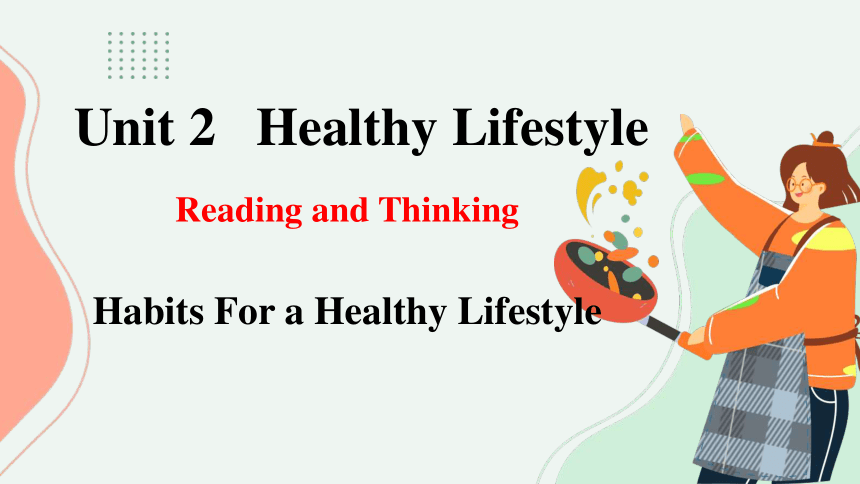 | |
| 格式 | pptx | ||
| 文件大小 | 45.2MB | ||
| 资源类型 | 教案 | ||
| 版本资源 | 人教版(2019) | ||
| 科目 | 英语 | ||
| 更新时间 | 2024-09-10 12:41:05 | ||
图片预览

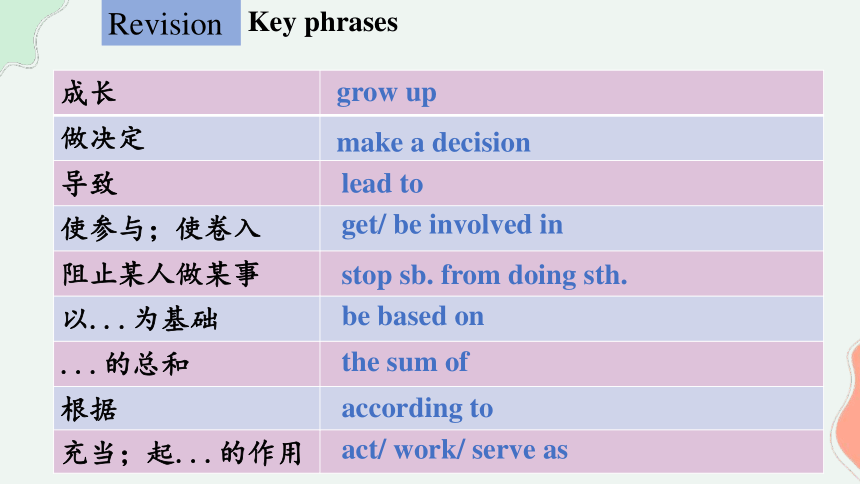
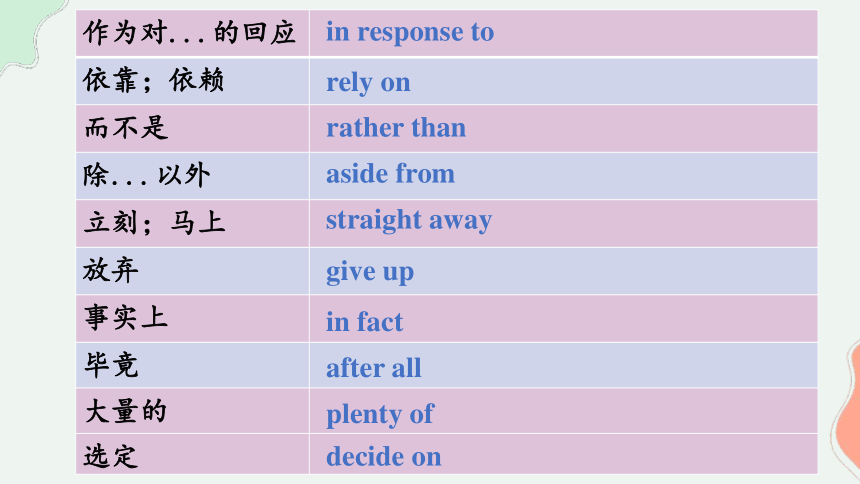
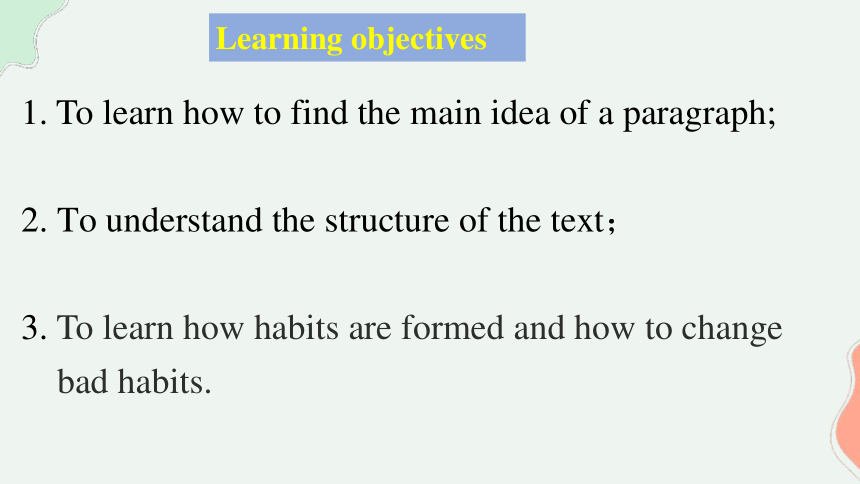
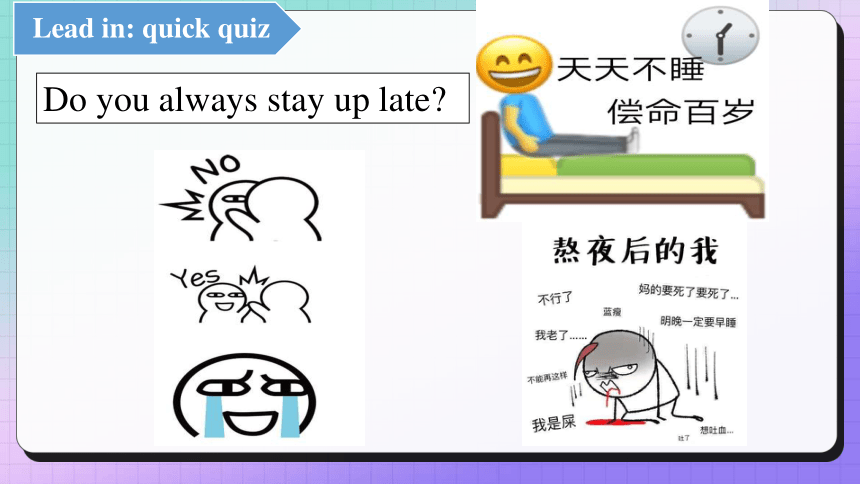
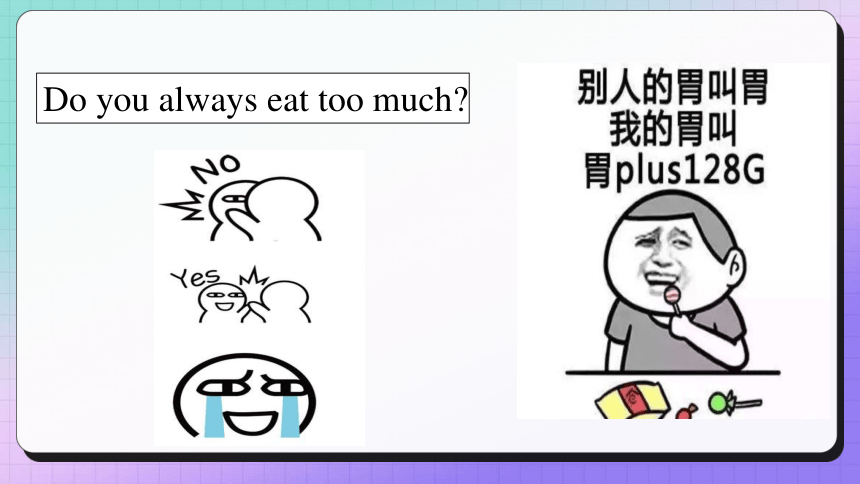
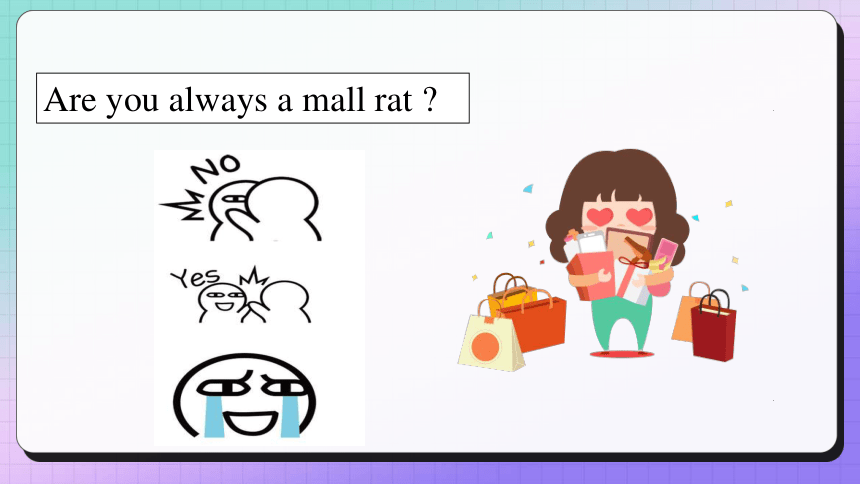
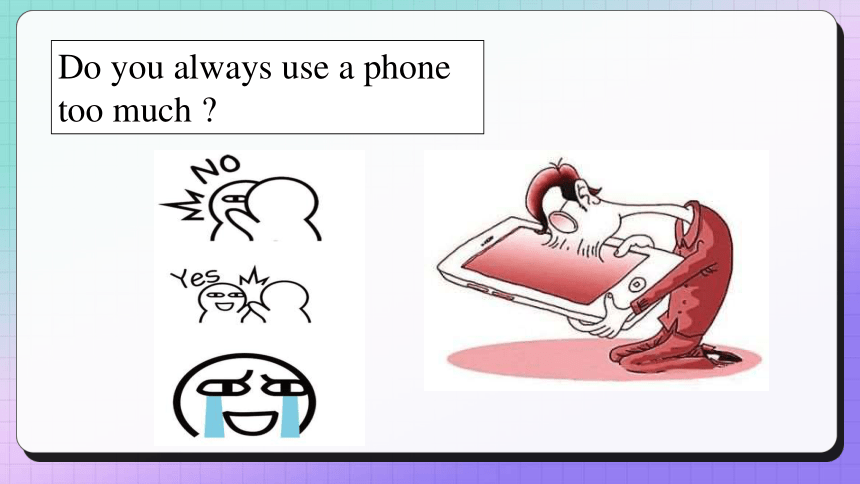

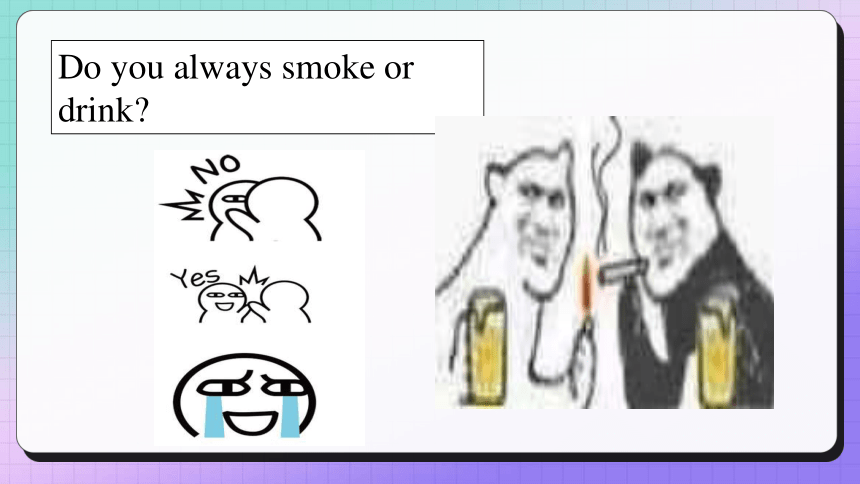

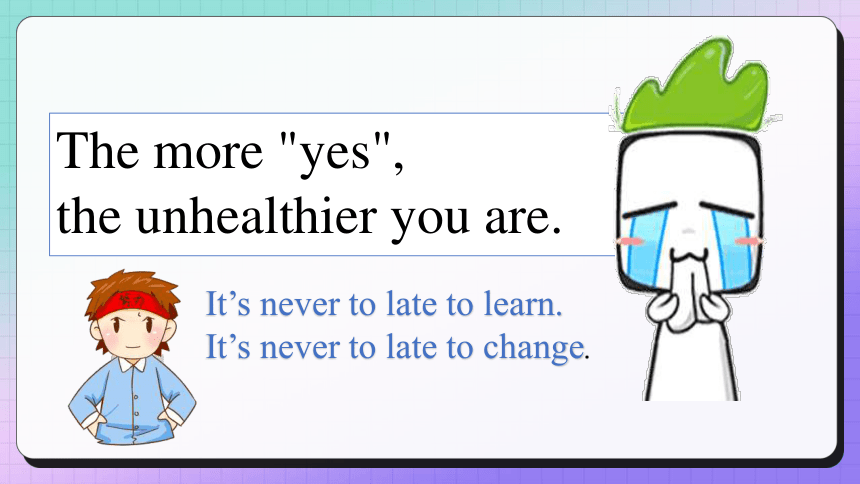
文档简介
(共30张PPT)
Unit 2 Healthy Lifestyle
Reading and Thinking
Habits For a Healthy Lifestyle
Revision
成长
做决定
导致
使参与;使卷入
阻止某人做某事
以...为基础
...的总和
根据
充当;起...的作用
Key phrases
grow up
make a decision
lead to
get/ be involved in
stop sb. from doing sth.
be based on
the sum of
according to
act/ work/ serve as
作为对...的回应
依靠;依赖
而不是
除...以外
立刻;马上
放弃
事实上
毕竟
大量的
选定
in response to
rely on
rather than
aside from
straight away
give up
in fact
after all
plenty of
decide on
1. To learn how to find the main idea of a paragraph;
2. To understand the structure of the text;
3. To learn how habits are formed and how to change
bad habits.
Learning objectives
Do you always stay up late
Lead in: quick quiz
Do you always eat too much
Are you always a mall rat
Do you always use a phone too much
Do you always drink too much coffee
Do you always smoke or drink
Do you always exercise
The more "yes",
the unhealthier you are.
It’s never to late to learn.
It’s never to late to change.
What other unhealthy habits do you have
Drinking alcohol
Cigarette Smoking
Diet
Digital addiction
What can you do to correct these bad habits
take more exercise
have a healthy diet
eat less junk food
Read and predict main idea:
An exposition
An argumentation
An exposition
An argumentation
Pre-reading: Prediction
An exposition is a type of writing to explain...
An argumentation is a type of writing to convince...
Match the main ideas with each of the paragraphs.
A. How to change a bad habit and create good ones
The cycle of how habits are formed
Habits that can help us study better
Changing habits gradually
No easy way to change bad habits
What a habit is
Why bad teenage habits should be changed
Para. 1
Para. 2
Para. 3
Para. 4
Para. 5
Para. 6
Fast Reading
Match the main ideas with each of the paragraphs.
A. How to change a bad habit and create good ones
The cycle of how habits are formed
Changing habits gradually
No easy way to change bad habits
What a habit is
Why bad teenage habits should be changed
Para. 1
Para. 2
Para. 3
Para. 4
Para. 5
Para. 6
Fast Reading
4. How to change a bad habit and create good ones.
3. The cycle of how habits are formed.
5. Changing habits gradually.
6. No easy way to change bad habits.
2. What a habit is.
1. Why bad teenage habits should be changed.
Exposition
the problem
the problem
the problem
raise, analyze, solve, conclusion
raise
analyse
solve
conclusion
problem-solving pattern
Read for the structure
As teenagers grow up, they become more independent and start making their own decisions. However, during this period, it can be easy for some of them to form bad habits. These bad habits, if left unchecked, could lead to more serious ones when they become adults. For example some of them may become involved in tobacco or alcohol abuse, which can lead to physical and mental health problems. To prevent harmful habits like these from dominating a teenager's life is essential. They must learn to recognise bad habits early and make appropriate changes.
Q1: Why should bad teenage habits be changed
Q 2: How does the author develop the paragraph
By giving examples.
Reading for details
Para 1
Raise the problem
To change bad habits is never easy, even with many attempts. There is a famous saying based on the philosophy of Aristotle: “We are what we repeatedly do.” In many ways, our lifestyle is the sum of choices we have made. We make a choice to do something, and then we repeat it over and over again. Soon that choice becomes automatic and forms a habit that is much harder to change. The good news is that we can change, if we understand how habits work.
Q1: How can a choice lead to a habit
Q2: How does the author develop the paragraph
Para 2
By directly quoting.
Analyze the problem
According to modern psychology, we must first learn about the “habit cycle”, which works like this:
Firstly, there is “cue”, an action, event, or situation that acts as a signal to do something.
Secondly, there is a “routine”, the regular action you take in response to the cue.
Thirdly, there is a “reward”, the good thing or feeling we get from the routine.
For example, when we feel unhappy (cue), we eat lots of unhealthy snacks (routine), which makes us feel happy (reward). The reward makes us more likely to continue the cycle, and the bad habit of relying on unhealthy snacks is formed.
Q1: What is the three stages of habit cycle and what are they refer to
Q 2: How does the author develop the paragraph
Para 3
By giving definitions and examples.
To facilitate a positive change in our bad habits, we must first examine our bad habit cycles and then try to adapt them. We can do this by combining the information from our habit cycles with our own positive ideas. For example, we could try to replace a negative routine with something more positive. So, when we feel unhappy again (cue), rather than eat snacks, we could listen to some of our favourite music instead (routine), which will make us feel relaxed (reward). Aside from changing bad habits, we can also use the habit cycle to create good habits. For example, when we come to an escalator(cue), our normal routine is to ride it, but we could change this routine into something more positive by taking the stairs instead.
Q1: What can we do to change bad habits with “habit cycle”
Q2: How does the author develop the paragraph
Para 4
Solve the problem
By giving examples.
Many of us try to change bad habits quickly and if we are not successful straight away, we often become pessimistic and give up. In fact, the most successful way to change is not suddenly, but over a period of time. As the Chinese philosopher Lao Zi wrote, “A journey of a thousand miles begins with a single step. "One step seems small, but it is essential. To reach the goal of change, a person must show some discipline and repeatedly take many small steps. After all, it is not easy to break bad habits .
Q1: Do you think we can change the bad habits immediately
Q2: What else are needed if we want to change a bad habit
A.time B.discipline C.repeated small steps D.all of above
Q3: How does the author develop the paragraph
Para 5
By directly quoting.
Q1.What do “magic pill” and “delete button” refer to
Q2.What’s the author’s attitude towards changing bad habits
A.Negative. B.Sad. C.Doubtful. D.Positive.
Para 6
For young people, there is plenty of time to change bad habits. However, there is no “magic pill” or delete button that will help you; you have to think about your bad habits and decide on some changes. You have the power to build a happy and healthy life full of good habits!
Conclusion
Metaphor暗喻
A quick way / Shortcut
How to change your unhealthy habits
①Draw two habit cycles of your own.
②Prepare a short presentation and then practice with your group members
1. To introduce your habit:
To be honest/Frankly speaking(坦白说), I have formed an unhealthy habit. That is xxx.
2.To describe the habit cycle:
In my case, when I ……(cue), I do ……(rountine). Therefore, I feel ……(reward).
3. To show how to change it:
Next time when I ……(cue), I will ……(rountine). Thus, I will ……(reward).
Post-reading
Test for goals
As teenagers grow up, they become more independent and start making their own 1________(decide). However, during this period, it can be easy for some of them 2________(form) bad habits. These bad habits, if 3_____(leave) unchecked, could lead 4___more serious ones when they become adults. 5_________(change) bad habits is never easy, even with many attempts.The good news is that we can change our bad habits if we understand 6______habits work. To facilitate 7____
positive change in our bad habits, we must first examine 8_____(we) bad habit cycles and then try to adapt them.We can do this by 9__________(combine) the information from our habit cycles 10_____ our own positive ideas.We can also use the habit cycle 11________(create) good habits. Many of us try to change bad habits 12________(quick), and if we are not successful straight 13_____, we often become pessimistic and give up. In fact, the 14_______________(success) way to change is not suddenly, 15_____ over a period of time.To reach the goal of change, a person must 16__________ (repeat) take many small steps.Young people have the power 17_______(build) a happy and 18_______(health) life full of good habits!
decisions
to form
left
to
To change
how
a
our
combining
with
to creat
quickly
away
most successful
but
repeatedly
to build
healthy
Thank you !
Unit 2 Healthy Lifestyle
Reading and Thinking
Habits For a Healthy Lifestyle
Revision
成长
做决定
导致
使参与;使卷入
阻止某人做某事
以...为基础
...的总和
根据
充当;起...的作用
Key phrases
grow up
make a decision
lead to
get/ be involved in
stop sb. from doing sth.
be based on
the sum of
according to
act/ work/ serve as
作为对...的回应
依靠;依赖
而不是
除...以外
立刻;马上
放弃
事实上
毕竟
大量的
选定
in response to
rely on
rather than
aside from
straight away
give up
in fact
after all
plenty of
decide on
1. To learn how to find the main idea of a paragraph;
2. To understand the structure of the text;
3. To learn how habits are formed and how to change
bad habits.
Learning objectives
Do you always stay up late
Lead in: quick quiz
Do you always eat too much
Are you always a mall rat
Do you always use a phone too much
Do you always drink too much coffee
Do you always smoke or drink
Do you always exercise
The more "yes",
the unhealthier you are.
It’s never to late to learn.
It’s never to late to change.
What other unhealthy habits do you have
Drinking alcohol
Cigarette Smoking
Diet
Digital addiction
What can you do to correct these bad habits
take more exercise
have a healthy diet
eat less junk food
Read and predict main idea:
An exposition
An argumentation
An exposition
An argumentation
Pre-reading: Prediction
An exposition is a type of writing to explain...
An argumentation is a type of writing to convince...
Match the main ideas with each of the paragraphs.
A. How to change a bad habit and create good ones
The cycle of how habits are formed
Habits that can help us study better
Changing habits gradually
No easy way to change bad habits
What a habit is
Why bad teenage habits should be changed
Para. 1
Para. 2
Para. 3
Para. 4
Para. 5
Para. 6
Fast Reading
Match the main ideas with each of the paragraphs.
A. How to change a bad habit and create good ones
The cycle of how habits are formed
Changing habits gradually
No easy way to change bad habits
What a habit is
Why bad teenage habits should be changed
Para. 1
Para. 2
Para. 3
Para. 4
Para. 5
Para. 6
Fast Reading
4. How to change a bad habit and create good ones.
3. The cycle of how habits are formed.
5. Changing habits gradually.
6. No easy way to change bad habits.
2. What a habit is.
1. Why bad teenage habits should be changed.
Exposition
the problem
the problem
the problem
raise, analyze, solve, conclusion
raise
analyse
solve
conclusion
problem-solving pattern
Read for the structure
As teenagers grow up, they become more independent and start making their own decisions. However, during this period, it can be easy for some of them to form bad habits. These bad habits, if left unchecked, could lead to more serious ones when they become adults. For example some of them may become involved in tobacco or alcohol abuse, which can lead to physical and mental health problems. To prevent harmful habits like these from dominating a teenager's life is essential. They must learn to recognise bad habits early and make appropriate changes.
Q1: Why should bad teenage habits be changed
Q 2: How does the author develop the paragraph
By giving examples.
Reading for details
Para 1
Raise the problem
To change bad habits is never easy, even with many attempts. There is a famous saying based on the philosophy of Aristotle: “We are what we repeatedly do.” In many ways, our lifestyle is the sum of choices we have made. We make a choice to do something, and then we repeat it over and over again. Soon that choice becomes automatic and forms a habit that is much harder to change. The good news is that we can change, if we understand how habits work.
Q1: How can a choice lead to a habit
Q2: How does the author develop the paragraph
Para 2
By directly quoting.
Analyze the problem
According to modern psychology, we must first learn about the “habit cycle”, which works like this:
Firstly, there is “cue”, an action, event, or situation that acts as a signal to do something.
Secondly, there is a “routine”, the regular action you take in response to the cue.
Thirdly, there is a “reward”, the good thing or feeling we get from the routine.
For example, when we feel unhappy (cue), we eat lots of unhealthy snacks (routine), which makes us feel happy (reward). The reward makes us more likely to continue the cycle, and the bad habit of relying on unhealthy snacks is formed.
Q1: What is the three stages of habit cycle and what are they refer to
Q 2: How does the author develop the paragraph
Para 3
By giving definitions and examples.
To facilitate a positive change in our bad habits, we must first examine our bad habit cycles and then try to adapt them. We can do this by combining the information from our habit cycles with our own positive ideas. For example, we could try to replace a negative routine with something more positive. So, when we feel unhappy again (cue), rather than eat snacks, we could listen to some of our favourite music instead (routine), which will make us feel relaxed (reward). Aside from changing bad habits, we can also use the habit cycle to create good habits. For example, when we come to an escalator(cue), our normal routine is to ride it, but we could change this routine into something more positive by taking the stairs instead.
Q1: What can we do to change bad habits with “habit cycle”
Q2: How does the author develop the paragraph
Para 4
Solve the problem
By giving examples.
Many of us try to change bad habits quickly and if we are not successful straight away, we often become pessimistic and give up. In fact, the most successful way to change is not suddenly, but over a period of time. As the Chinese philosopher Lao Zi wrote, “A journey of a thousand miles begins with a single step. "One step seems small, but it is essential. To reach the goal of change, a person must show some discipline and repeatedly take many small steps. After all, it is not easy to break bad habits .
Q1: Do you think we can change the bad habits immediately
Q2: What else are needed if we want to change a bad habit
A.time B.discipline C.repeated small steps D.all of above
Q3: How does the author develop the paragraph
Para 5
By directly quoting.
Q1.What do “magic pill” and “delete button” refer to
Q2.What’s the author’s attitude towards changing bad habits
A.Negative. B.Sad. C.Doubtful. D.Positive.
Para 6
For young people, there is plenty of time to change bad habits. However, there is no “magic pill” or delete button that will help you; you have to think about your bad habits and decide on some changes. You have the power to build a happy and healthy life full of good habits!
Conclusion
Metaphor暗喻
A quick way / Shortcut
How to change your unhealthy habits
①Draw two habit cycles of your own.
②Prepare a short presentation and then practice with your group members
1. To introduce your habit:
To be honest/Frankly speaking(坦白说), I have formed an unhealthy habit. That is xxx.
2.To describe the habit cycle:
In my case, when I ……(cue), I do ……(rountine). Therefore, I feel ……(reward).
3. To show how to change it:
Next time when I ……(cue), I will ……(rountine). Thus, I will ……(reward).
Post-reading
Test for goals
As teenagers grow up, they become more independent and start making their own 1________(decide). However, during this period, it can be easy for some of them 2________(form) bad habits. These bad habits, if 3_____(leave) unchecked, could lead 4___more serious ones when they become adults. 5_________(change) bad habits is never easy, even with many attempts.The good news is that we can change our bad habits if we understand 6______habits work. To facilitate 7____
positive change in our bad habits, we must first examine 8_____(we) bad habit cycles and then try to adapt them.We can do this by 9__________(combine) the information from our habit cycles 10_____ our own positive ideas.We can also use the habit cycle 11________(create) good habits. Many of us try to change bad habits 12________(quick), and if we are not successful straight 13_____, we often become pessimistic and give up. In fact, the 14_______________(success) way to change is not suddenly, 15_____ over a period of time.To reach the goal of change, a person must 16__________ (repeat) take many small steps.Young people have the power 17_______(build) a happy and 18_______(health) life full of good habits!
decisions
to form
left
to
To change
how
a
our
combining
with
to creat
quickly
away
most successful
but
repeatedly
to build
healthy
Thank you !
